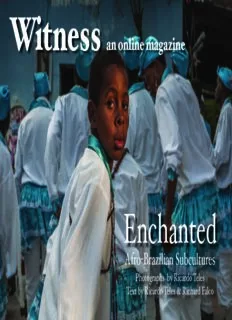
Enchanted: Afro-Brazilian Subcultures PDF
Preview Enchanted: Afro-Brazilian Subcultures
Witness an online magazine Enchanted Afro-Brazilian Subcultures Photographs by Ricardo Teles Text by Ricardo Teles & Richard Falco Enchanted Afro-Brazilian Subcultures Photographs by Ricardo Teles Text by Ricardo Teles & Richard Falco Black slavery in the Americas is a shameful institution for which all developed societies must take responsibility. Taken by force from their social and natural environment, Africans were condemned to be dispersed, interbred, marketed, and sold. Slavery endured for three hundred and fifty years in Brazil. It was the most perverse, long-lasting, and lucrative business in the New World. Today, approximately 50% of the total population has Afro-descendants. It is the second largest black nation in the world and it includes numerous African cultures within it. It is second only to Nigeria as the largest black nation in the world and it includes numerous African cultures within it. From the first economic boom, with the introduction of sugar- cane plantations in the colonial period beginning in the sixteenth century, slave labor underpinned the economic model that survived for over three centuries. There were few alternatives for resistance to this brutal reality. Among the best known are banzo, the name given to slow suicide as a result of inanition, and the quilombos, the uprisings and mass escapes to distant locations, hidden in the country’s forests. One of the most effective forms of resistance was the evolution of Afro-Brazilian cults and celebrations. Instead of self-destruction or war, they sought to face the harshest conditions with the disposition to endure. The artifice they used transformed the self-destructive impulses Liberty Day commemorates the slaves emancipation in Brazil in 1889. It is celebrated on May 13th. In many black communities, these festivities re-enact the punishments the slaves endured. (left) The procession of chains. The Liberty Day Festival in Contagem City, Brazil. The black community of Arturos in Contagem City, Minas Gerais State, re-enacts slave punishments on Liberty Day. into expressive ceremonies and artifacts, enabling them to overcome the The terrible afflictions suffered during the Atlantic crossings did threats of mute despair. not deprive the Africans of the memory of their gods or their ability to Despite the horrors and injustices of slavery, rich new social structures recognize the gods of others. developed. The diversity of these cultural and religious manifestations, many Afro-Brazilian culture was able to produce a religious and cultural with African origins, illustrates the persistence and vitality of numerous kaleidoscope originating in Mother Africa, which intrigues and fascinates us subcultures that thrive in Brazil today. in its multiple manifestations. That culture is dynamic. Born from a hybrid seed, it gave rise to the Afro-Brazilian cultural trunk that sprouted hundreds of the uniquely diverse branches. From the earliest days of the slave trade, many Christian slave owners and church leaders believed it was important to convert the enslaved Africans, and the impact of what has become Afro-Catholic traditions is readily apparent to this day. Almost all Afro-Brazilian cults have been influenced by some aspect of the Catholic faith. This evolution fused a difficult combination of orixas, inkices, and voduns (divinities and spiritual guides from ethnic groups separated not only by language and customs but often by the deep animosity of war, conquest, and slavery) with Catholicism. Even though the religions with African origins have a large number of followers, most have been continually persecuted and suffer enormous prejudice in Brazilian society. This is despite the fact that for a long time now they have not been exclusive to Afro-Brazilian descendants. The main source of condemnation came from the Catholic Church and a number of Pentecostal religions. It was not until these laws were changed in the 1970s that these religious freedoms were protected. A woman wears a metal mouth plate. Devices such as these where used by slave owners to punish and silence an individual. The Festa do Bonfim (Feast of Bonfim) is one of the most important popular Candomblé celebrations. Today, there are three main branches of religions with African origin. It takes place in Salvador, Brazil. They are: the Candomblé and Umbanda; the Irmandade de Nossa Senhora do Rosário (Brotherhood of Our Lady of the Rosary); and the pagan festivals that go back to the days of slavery, such as Lambe Sujo and Negro Fugido. Candomblé, the cult of the Orixas, represents the purest manifestation of African traditions in Brazil. In Africa, there is not one place where so many different rituals are practiced under one roof as occurs in the temples in Brazil. The Candomblé is a mixture of traditional Yoruba, Fon, and Bantu beliefs. Over time, it has incorporated some aspects of the Catholic faith. The name Candomblé means “dance in honour of the gods.” Candomblé practitioners believe that every person has their own individual orixa which controls his or her destiny and acts as a protector. Music and dance are important parts of Candomblé ceremonies. There is no concept of good or bad in Candomblé. Each person is only required to fulfil his or her destiny to the fullest, regardless of what that is.1 Despite persecution throughout the centuries, it is impressive that Candomblé has lasted until today. The group has some two million followers. 1Candomblé, BBC, http://www.bbc.co.uk/religion/religions/candomble Pilgrims gather in front of the Fanti Ashanti spiritual house, headed by Father Euclides, during the Divine Holy Spirit Feast in São Luís City. Practitioners assemble for services in the Fanti Ashanti spiritual house. Services conducted by the Tambor de Mina cult at the Turquia spiritual house in São Luis City, Brazil. The spiritual house was founded in 1889 by Mother Anastácia.
Description: